ignition CHEVROLET EXPRESS CARGO 2021 Owner's Manual
[x] Cancel search | Manufacturer: CHEVROLET, Model Year: 2021, Model line: EXPRESS CARGO, Model: CHEVROLET EXPRESS CARGO 2021Pages: 296, PDF Size: 6.68 MB
Page 7 of 296

Chevrolet Express Owner Manual (GMNA-Localizing-U.S./Canada/Mexico-
14583525) - 2021 - CRC - 12/9/20
6 Keys, Doors, and Windows
Keys, Doors, and
Windows
Keys and Locks
Keys . . . . . . . . . . . . . . . . . . . . . . . . . . . . . . . . . . . . . 6
Remote Keyless Entry (RKE) System . . . . . 8
Remote Keyless Entry (RKE) SystemOperation . . . . . . . . . . . . . . . . . . . . . . . . . . . . . . 8
Remote Vehicle Start . . . . . . . . . . . . . . . . . . . 10
Door Locks . . . . . . . . . . . . . . . . . . . . . . . . . . . . . . 11
Power Door Locks . . . . . . . . . . . . . . . . . . . . . . . 11
Cargo Door Relocking . . . . . . . . . . . . . . . . . . . 11
Delayed Locking . . . . . . . . . . . . . . . . . . . . . . . . 12
Automatic Door Locks . . . . . . . . . . . . . . . . . . . 12
Lockout Protection . . . . . . . . . . . . . . . . . . . . . . 12
Safety Locks . . . . . . . . . . . . . . . . . . . . . . . . . . . . 12
Safety Locks . . . . . . . . . . . . . . . . . . . . . . . . . . . . 12
Doors
Side Door (60/40 Swing-Out) . . . . . . . . . . . 13
Sliding Door . . . . . . . . . . . . . . . . . . . . . . . . . . . . 14
Rear Doors . . . . . . . . . . . . . . . . . . . . . . . . . . . . . . 15
Vehicle Security
Vehicle Security . . . . . . . . . . . . . . . . . . . . . . . . . 15
Vehicle Alarm System . . . . . . . . . . . . . . . . . . 16
Immobilizer . . . . . . . . . . . . . . . . . . . . . . . . . . . . . 16
Immobilizer Operation . . . . . . . . . . . . . . . . . . 17
Exterior Mirrors
Convex Mirrors . . . . . . . . . . . . . . . . . . . . . . . . . 17
Manual Mirrors . . . . . . . . . . . . . . . . . . . . . . . . . 18
Trailer-Tow Mirrors . . . . . . . . . . . . . . . . . . . . . 18
Power Mirrors . . . . . . . . . . . . . . . . . . . . . . . . . . 18
Folding Mirrors . . . . . . . . . . . . . . . . . . . . . . . . . 19
Heated Mirrors . . . . . . . . . . . . . . . . . . . . . . . . . 19
Interior Mirrors
Interior Rearview Mirrors . . . . . . . . . . . . . . . 19
Manual Rearview Mirror . . . . . . . . . . . . . . . . 19
Windows
Windows . . . . . . . . . . . . . . . . . . . . . . . . . . . . . . . 19
Manual Windows . . . . . . . . . . . . . . . . . . . . . . . 19
Power Windows . . . . . . . . . . . . . . . . . . . . . . . . 20
Swing-Out Windows . . . . . . . . . . . . . . . . . . . . 20
Enhanced Technology Glass . . . . . . . . . . . . . 21
Rear Windows . . . . . . . . . . . . . . . . . . . . . . . . . . 21
Sun Visors . . . . . . . . . . . . . . . . . . . . . . . . . . . . . . 21
Keys and Locks
Keys
{Warning
Leaving children in a vehicle with the
ignition key is dangerous and children or
others could be seriously injured or killed.
They could operate the power windows
or other controls or make the vehicle
move. The windows will function with
the keys in the ignition, and children or
others could be caught in the path of a
closing window. Do not leave children in
a vehicle with the ignition key.
Page 8 of 296
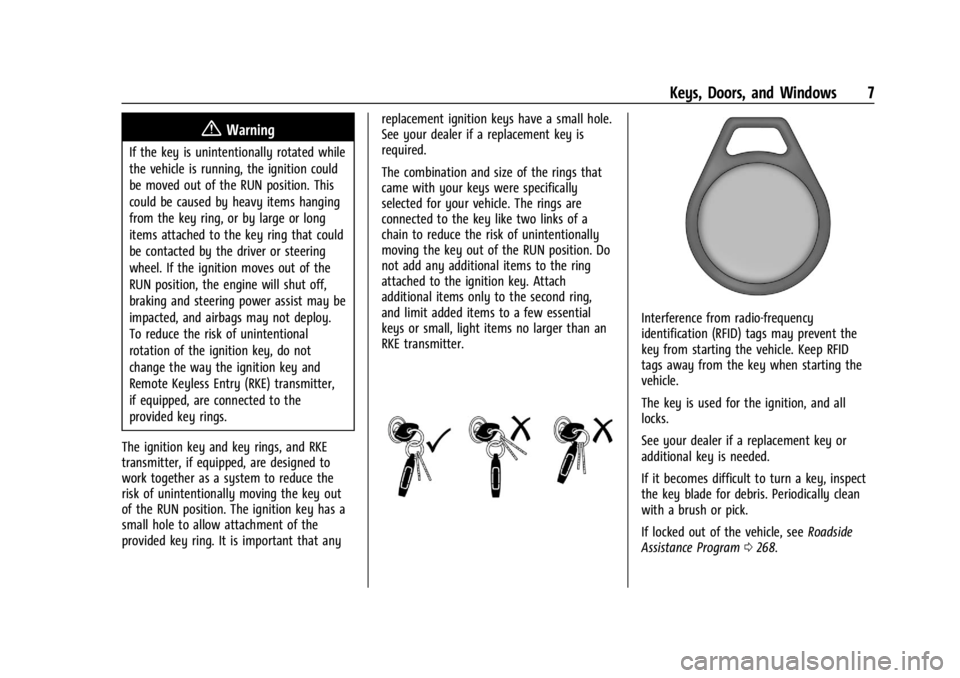
Chevrolet Express Owner Manual (GMNA-Localizing-U.S./Canada/Mexico-
14583525) - 2021 - CRC - 12/9/20
Keys, Doors, and Windows 7
{Warning
If the key is unintentionally rotated while
the vehicle is running, the ignition could
be moved out of the RUN position. This
could be caused by heavy items hanging
from the key ring, or by large or long
items attached to the key ring that could
be contacted by the driver or steering
wheel. If the ignition moves out of the
RUN position, the engine will shut off,
braking and steering power assist may be
impacted, and airbags may not deploy.
To reduce the risk of unintentional
rotation of the ignition key, do not
change the way the ignition key and
Remote Keyless Entry (RKE) transmitter,
if equipped, are connected to the
provided key rings.
The ignition key and key rings, and RKE
transmitter, if equipped, are designed to
work together as a system to reduce the
risk of unintentionally moving the key out
of the RUN position. The ignition key has a
small hole to allow attachment of the
provided key ring. It is important that any replacement ignition keys have a small hole.
See your dealer if a replacement key is
required.
The combination and size of the rings that
came with your keys were specifically
selected for your vehicle. The rings are
connected to the key like two links of a
chain to reduce the risk of unintentionally
moving the key out of the RUN position. Do
not add any additional items to the ring
attached to the ignition key. Attach
additional items only to the second ring,
and limit added items to a few essential
keys or small, light items no larger than an
RKE transmitter.
Interference from radio-frequency
identification (RFID) tags may prevent the
key from starting the vehicle. Keep RFID
tags away from the key when starting the
vehicle.
The key is used for the ignition, and all
locks.
See your dealer if a replacement key or
additional key is needed.
If it becomes difficult to turn a key, inspect
the key blade for debris. Periodically clean
with a brush or pick.
If locked out of the vehicle, see
Roadside
Assistance Program 0268.
Page 9 of 296
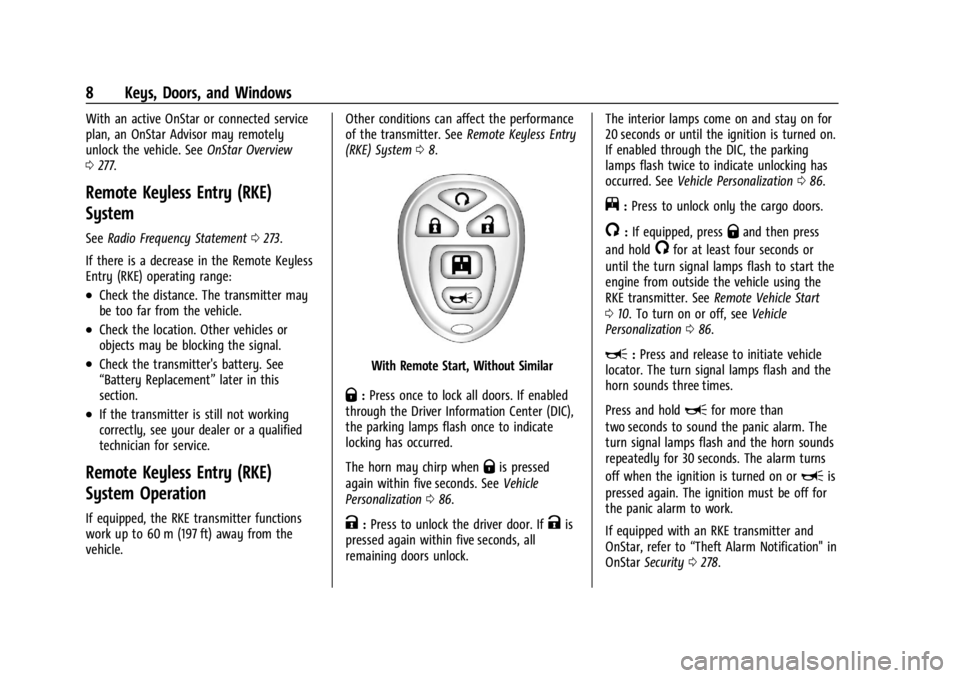
Chevrolet Express Owner Manual (GMNA-Localizing-U.S./Canada/Mexico-
14583525) - 2021 - CRC - 12/9/20
8 Keys, Doors, and Windows
With an active OnStar or connected service
plan, an OnStar Advisor may remotely
unlock the vehicle. SeeOnStar Overview
0 277.
Remote Keyless Entry (RKE)
System
See Radio Frequency Statement 0273.
If there is a decrease in the Remote Keyless
Entry (RKE) operating range:
.Check the distance. The transmitter may
be too far from the vehicle.
.Check the location. Other vehicles or
objects may be blocking the signal.
.Check the transmitter's battery. See
“Battery Replacement” later in this
section.
.If the transmitter is still not working
correctly, see your dealer or a qualified
technician for service.
Remote Keyless Entry (RKE)
System Operation
If equipped, the RKE transmitter functions
work up to 60 m (197 ft) away from the
vehicle. Other conditions can affect the performance
of the transmitter. See
Remote Keyless Entry
(RKE) System 08.
With Remote Start, Without Similar
Q:Press once to lock all doors. If enabled
through the Driver Information Center (DIC),
the parking lamps flash once to indicate
locking has occurred.
The horn may chirp when
Qis pressed
again within five seconds. See Vehicle
Personalization 086.
K:Press to unlock the driver door. IfKis
pressed again within five seconds, all
remaining doors unlock. The interior lamps come on and stay on for
20 seconds or until the ignition is turned on.
If enabled through the DIC, the parking
lamps flash twice to indicate unlocking has
occurred. See
Vehicle Personalization 086.
j:Press to unlock only the cargo doors.
/:If equipped, pressQand then press
and hold
/for at least four seconds or
until the turn signal lamps flash to start the
engine from outside the vehicle using the
RKE transmitter. See Remote Vehicle Start
0 10. To turn on or off, see Vehicle
Personalization 086.
L:Press and release to initiate vehicle
locator. The turn signal lamps flash and the
horn sounds three times.
Press and hold
Lfor more than
two seconds to sound the panic alarm. The
turn signal lamps flash and the horn sounds
repeatedly for 30 seconds. The alarm turns
off when the ignition is turned on or
Lis
pressed again. The ignition must be off for
the panic alarm to work.
If equipped with an RKE transmitter and
OnStar, refer to “Theft Alarm Notification" in
OnStar Security 0278.
Page 11 of 296
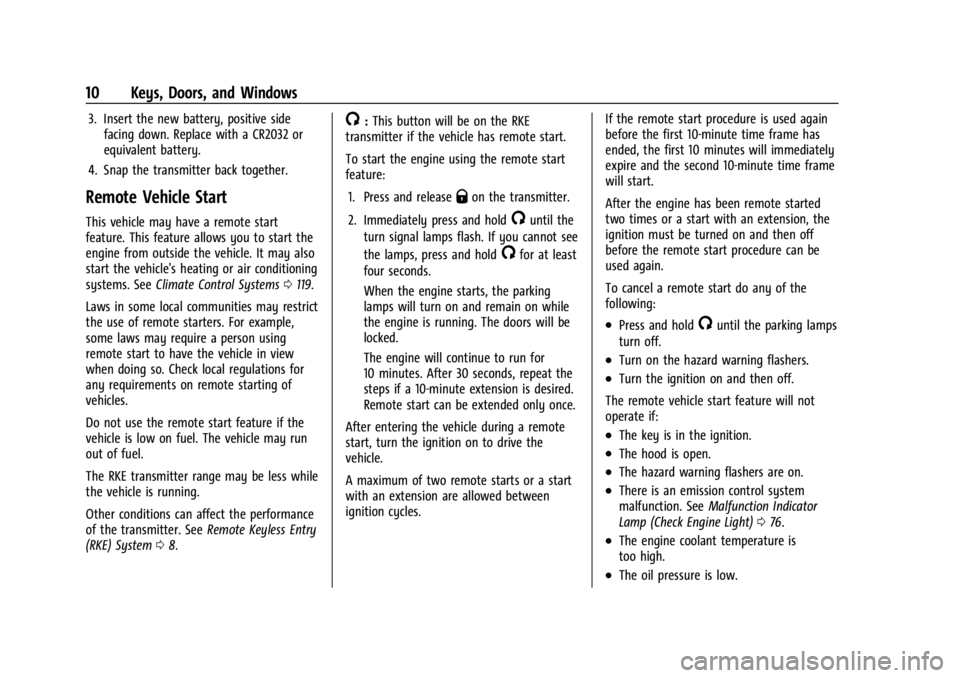
Chevrolet Express Owner Manual (GMNA-Localizing-U.S./Canada/Mexico-
14583525) - 2021 - CRC - 12/9/20
10 Keys, Doors, and Windows
3. Insert the new battery, positive sidefacing down. Replace with a CR2032 or
equivalent battery.
4. Snap the transmitter back together.
Remote Vehicle Start
This vehicle may have a remote start
feature. This feature allows you to start the
engine from outside the vehicle. It may also
start the vehicle's heating or air conditioning
systems. See Climate Control Systems 0119.
Laws in some local communities may restrict
the use of remote starters. For example,
some laws may require a person using
remote start to have the vehicle in view
when doing so. Check local regulations for
any requirements on remote starting of
vehicles.
Do not use the remote start feature if the
vehicle is low on fuel. The vehicle may run
out of fuel.
The RKE transmitter range may be less while
the vehicle is running.
Other conditions can affect the performance
of the transmitter. See Remote Keyless Entry
(RKE) System 08.
/:This button will be on the RKE
transmitter if the vehicle has remote start.
To start the engine using the remote start
feature:
1. Press and release
Qon the transmitter.
2. Immediately press and hold
/until the
turn signal lamps flash. If you cannot see
the lamps, press and hold
/for at least
four seconds.
When the engine starts, the parking
lamps will turn on and remain on while
the engine is running. The doors will be
locked.
The engine will continue to run for
10 minutes. After 30 seconds, repeat the
steps if a 10-minute extension is desired.
Remote start can be extended only once.
After entering the vehicle during a remote
start, turn the ignition on to drive the
vehicle.
A maximum of two remote starts or a start
with an extension are allowed between
ignition cycles. If the remote start procedure is used again
before the first 10-minute time frame has
ended, the first 10 minutes will immediately
expire and the second 10-minute time frame
will start.
After the engine has been remote started
two times or a start with an extension, the
ignition must be turned on and then off
before the remote start procedure can be
used again.
To cancel a remote start do any of the
following:
.Press and hold/until the parking lamps
turn off.
.Turn on the hazard warning flashers.
.Turn the ignition on and then off.
The remote vehicle start feature will not
operate if:
.The key is in the ignition.
.The hood is open.
.The hazard warning flashers are on.
.There is an emission control system
malfunction. See Malfunction Indicator
Lamp (Check Engine Light) 076.
.The engine coolant temperature is
too high.
.The oil pressure is low.
Page 13 of 296

Chevrolet Express Owner Manual (GMNA-Localizing-U.S./Canada/Mexico-
14583525) - 2021 - CRC - 12/9/20
12 Keys, Doors, and Windows
Delayed Locking
When locking the doors with the power lock
switch and a door open, the doors will lock
five seconds after the last door is closed. The
horn chirps to signal that the delayed
locking feature is in use.
Pressing
eorQon the RKE transmitter
will override the delayed locking feature and
immediately lock all the doors.
This feature will not operate if the key is in
the ignition.
This feature can be programmed using the
Driver Information Center (DIC). See “DELAY
DOOR LOCK” inVehicle Personalization 086.
Automatic Door Locks
The vehicle may have an automatic lock/
unlock feature. This feature can be
programmed using the Driver Information
Center (DIC). See Vehicle Personalization
0 86.
Lockout Protection
This feature protects you from locking the
key in the vehicle when the key is in the
ignition and a door is open. If the power lock switch is pressed when
either the driver, passenger, or rear door is
open, all the doors will lock and then the
driver door will unlock. This feature does not
include the side cargo door.
If the vehicle has an ambulance package,
this feature is disabled.
Safety Locks
Security locks are located on the front
portion of the 60/40 side swing-out door or
the side sliding door.
60/40 Swing-Out Side Door - Passenger Side.
For the 60/40 side swing-out door, move the
button to the left for the passenger side
door to engage the security feature. Move the button to the right for the
passenger side door to return the door locks
to normal operation.
Side Sliding Door
For the side sliding door, move the button
up to engage the security feature. Move the
button down to return the door locks to
normal operation.
Safety Locks
Security locks are located on the front
portion of the 60/40 side swing-out door or
the side sliding door.
Page 18 of 296
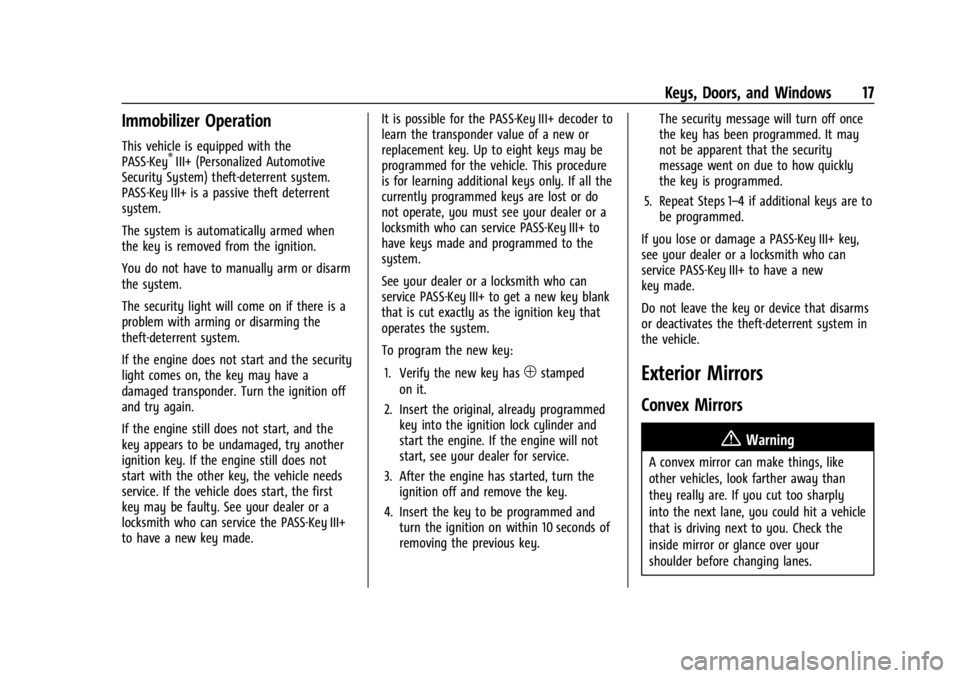
Chevrolet Express Owner Manual (GMNA-Localizing-U.S./Canada/Mexico-
14583525) - 2021 - CRC - 12/9/20
Keys, Doors, and Windows 17
Immobilizer Operation
This vehicle is equipped with the
PASS-Key®III+ (Personalized Automotive
Security System) theft-deterrent system.
PASS-Key III+ is a passive theft deterrent
system.
The system is automatically armed when
the key is removed from the ignition.
You do not have to manually arm or disarm
the system.
The security light will come on if there is a
problem with arming or disarming the
theft-deterrent system.
If the engine does not start and the security
light comes on, the key may have a
damaged transponder. Turn the ignition off
and try again.
If the engine still does not start, and the
key appears to be undamaged, try another
ignition key. If the engine still does not
start with the other key, the vehicle needs
service. If the vehicle does start, the first
key may be faulty. See your dealer or a
locksmith who can service the PASS-Key III+
to have a new key made. It is possible for the PASS-Key III+ decoder to
learn the transponder value of a new or
replacement key. Up to eight keys may be
programmed for the vehicle. This procedure
is for learning additional keys only. If all the
currently programmed keys are lost or do
not operate, you must see your dealer or a
locksmith who can service PASS-Key III+ to
have keys made and programmed to the
system.
See your dealer or a locksmith who can
service PASS-Key III+ to get a new key blank
that is cut exactly as the ignition key that
operates the system.
To program the new key:
1. Verify the new key has
1stamped
on it.
2. Insert the original, already programmed key into the ignition lock cylinder and
start the engine. If the engine will not
start, see your dealer for service.
3. After the engine has started, turn the ignition off and remove the key.
4. Insert the key to be programmed and turn the ignition on within 10 seconds of
removing the previous key. The security message will turn off once
the key has been programmed. It may
not be apparent that the security
message went on due to how quickly
the key is programmed.
5. Repeat Steps 1–4 if additional keys are to be programmed.
If you lose or damage a PASS-Key III+ key,
see your dealer or a locksmith who can
service PASS-Key III+ to have a new
key made.
Do not leave the key or device that disarms
or deactivates the theft-deterrent system in
the vehicle.Exterior Mirrors
Convex Mirrors
{Warning
A convex mirror can make things, like
other vehicles, look farther away than
they really are. If you cut too sharply
into the next lane, you could hit a vehicle
that is driving next to you. Check the
inside mirror or glance over your
shoulder before changing lanes.
Page 21 of 296
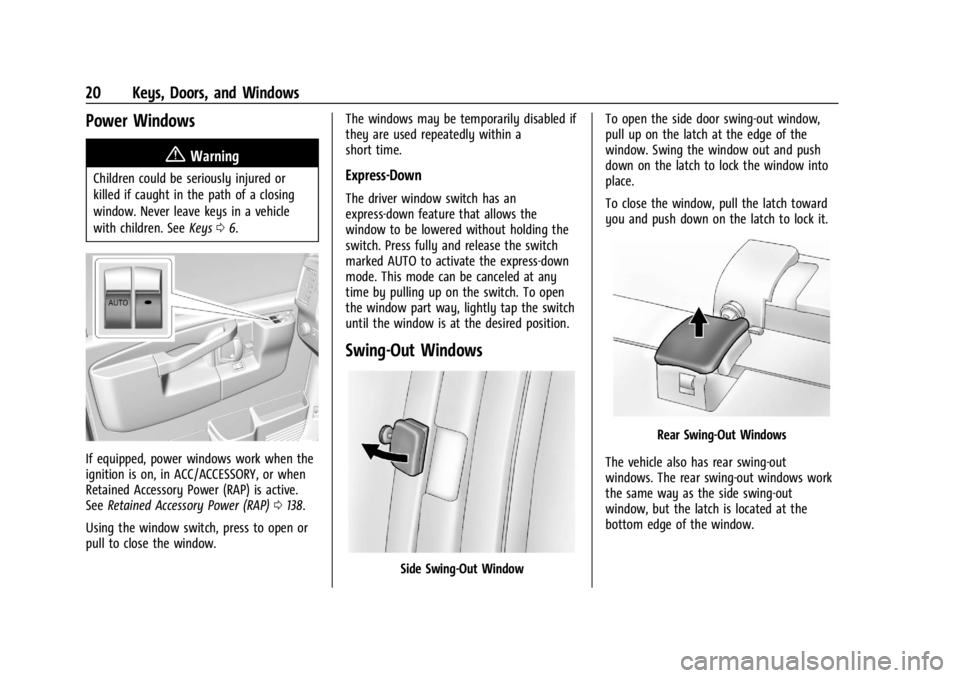
Chevrolet Express Owner Manual (GMNA-Localizing-U.S./Canada/Mexico-
14583525) - 2021 - CRC - 12/9/20
20 Keys, Doors, and Windows
Power Windows
{Warning
Children could be seriously injured or
killed if caught in the path of a closing
window. Never leave keys in a vehicle
with children. SeeKeys06.
If equipped, power windows work when the
ignition is on, in ACC/ACCESSORY, or when
Retained Accessory Power (RAP) is active.
See Retained Accessory Power (RAP) 0138.
Using the window switch, press to open or
pull to close the window. The windows may be temporarily disabled if
they are used repeatedly within a
short time.
Express-Down
The driver window switch has an
express-down feature that allows the
window to be lowered without holding the
switch. Press fully and release the switch
marked AUTO to activate the express-down
mode. This mode can be canceled at any
time by pulling up on the switch. To open
the window part way, lightly tap the switch
until the window is at the desired position.
Swing-Out Windows
Side Swing-Out WindowTo open the side door swing-out window,
pull up on the latch at the edge of the
window. Swing the window out and push
down on the latch to lock the window into
place.
To close the window, pull the latch toward
you and push down on the latch to lock it.
Rear Swing‐Out Windows
The vehicle also has rear swing‐out
windows. The rear swing-out windows work
the same way as the side swing‐out
window, but the latch is located at the
bottom edge of the window.
Page 24 of 296

Chevrolet Express Owner Manual (GMNA-Localizing-U.S./Canada/Mexico-
14583525) - 2021 - CRC - 12/9/20
Seats and Restraints 23
To adjust the seat:1. Lift the bar under the front edge of the seat cushion to unlock the seat.
2. Slide the seat to the desired position and release the bar.
3. Try to move the seat back and forth to be sure the seat is locked in place.
Power Seat Adjustment
{Warning
The power seats will work with the
ignition off. Children could operate the
power seats and be injured. Never leave
children alone in the vehicle.
To adjust a power seat, if available, use the
controls on the front of the seat:
.Move the center knob to the right or left
to move the seat forward or rearward.
.Move the center knob up or down to
raise or lower the seat.
.Move the right or left lever up or down
to raise or lower the front or rear of the
seat cushion.
Reclining Seatbacks
{Warning
If either seatback is not locked, it could
move forward in a sudden stop or crash.
That could cause injury to the person
sitting there. Always push and pull on
the seatbacks to be sure they are locked.
To recline the seatback:
1. Lift the lever on the inboard side of the seat.
2. Move the seatback to the desired position, and then release the lever to
lock the seatback in place.
Page 42 of 296
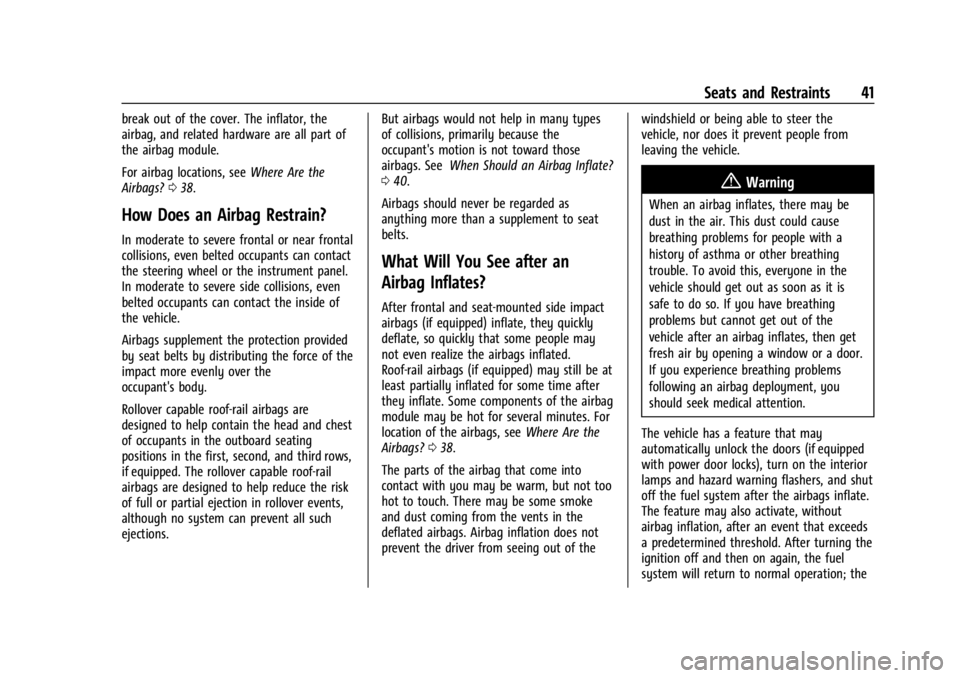
Chevrolet Express Owner Manual (GMNA-Localizing-U.S./Canada/Mexico-
14583525) - 2021 - CRC - 12/9/20
Seats and Restraints 41
break out of the cover. The inflator, the
airbag, and related hardware are all part of
the airbag module.
For airbag locations, seeWhere Are the
Airbags? 038.
How Does an Airbag Restrain?
In moderate to severe frontal or near frontal
collisions, even belted occupants can contact
the steering wheel or the instrument panel.
In moderate to severe side collisions, even
belted occupants can contact the inside of
the vehicle.
Airbags supplement the protection provided
by seat belts by distributing the force of the
impact more evenly over the
occupant's body.
Rollover capable roof-rail airbags are
designed to help contain the head and chest
of occupants in the outboard seating
positions in the first, second, and third rows,
if equipped. The rollover capable roof-rail
airbags are designed to help reduce the risk
of full or partial ejection in rollover events,
although no system can prevent all such
ejections. But airbags would not help in many types
of collisions, primarily because the
occupant's motion is not toward those
airbags. See
When Should an Airbag Inflate?
0 40.
Airbags should never be regarded as
anything more than a supplement to seat
belts.
What Will You See after an
Airbag Inflates?
After frontal and seat-mounted side impact
airbags (if equipped) inflate, they quickly
deflate, so quickly that some people may
not even realize the airbags inflated.
Roof-rail airbags (if equipped) may still be at
least partially inflated for some time after
they inflate. Some components of the airbag
module may be hot for several minutes. For
location of the airbags, see Where Are the
Airbags? 038.
The parts of the airbag that come into
contact with you may be warm, but not too
hot to touch. There may be some smoke
and dust coming from the vents in the
deflated airbags. Airbag inflation does not
prevent the driver from seeing out of the windshield or being able to steer the
vehicle, nor does it prevent people from
leaving the vehicle.
{Warning
When an airbag inflates, there may be
dust in the air. This dust could cause
breathing problems for people with a
history of asthma or other breathing
trouble. To avoid this, everyone in the
vehicle should get out as soon as it is
safe to do so. If you have breathing
problems but cannot get out of the
vehicle after an airbag inflates, then get
fresh air by opening a window or a door.
If you experience breathing problems
following an airbag deployment, you
should seek medical attention.
The vehicle has a feature that may
automatically unlock the doors (if equipped
with power door locks), turn on the interior
lamps and hazard warning flashers, and shut
off the fuel system after the airbags inflate.
The feature may also activate, without
airbag inflation, after an event that exceeds
a predetermined threshold. After turning the
ignition off and then on again, the fuel
system will return to normal operation; the
Page 45 of 296
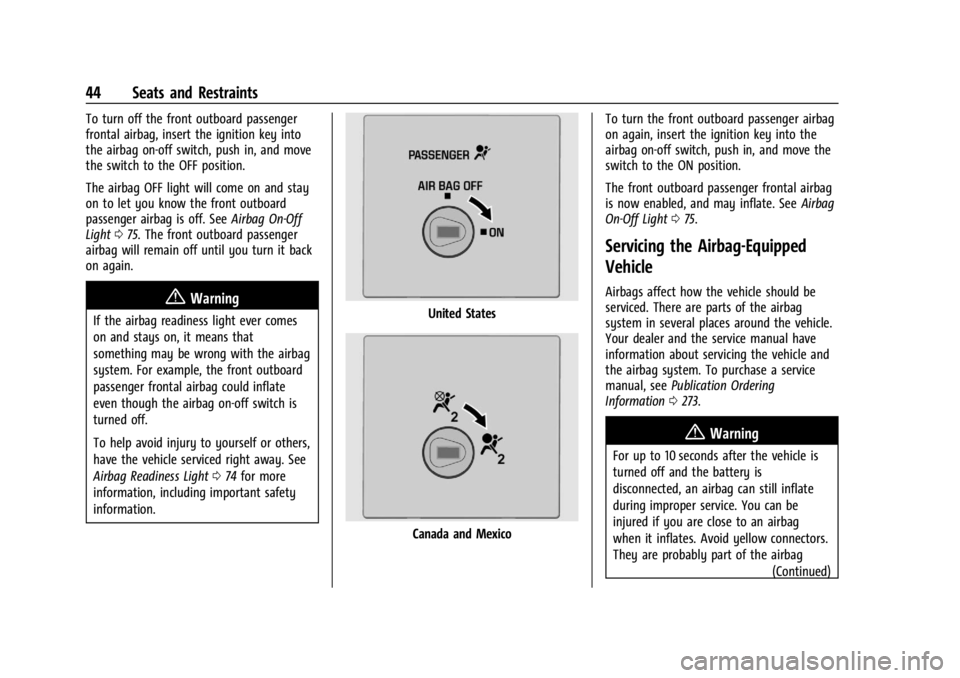
Chevrolet Express Owner Manual (GMNA-Localizing-U.S./Canada/Mexico-
14583525) - 2021 - CRC - 12/9/20
44 Seats and Restraints
To turn off the front outboard passenger
frontal airbag, insert the ignition key into
the airbag on-off switch, push in, and move
the switch to the OFF position.
The airbag OFF light will come on and stay
on to let you know the front outboard
passenger airbag is off. SeeAirbag On-Off
Light 075. The front outboard passenger
airbag will remain off until you turn it back
on again.
{Warning
If the airbag readiness light ever comes
on and stays on, it means that
something may be wrong with the airbag
system. For example, the front outboard
passenger frontal airbag could inflate
even though the airbag on-off switch is
turned off.
To help avoid injury to yourself or others,
have the vehicle serviced right away. See
Airbag Readiness Light 074 for more
information, including important safety
information.United States
Canada and Mexico To turn the front outboard passenger airbag
on again, insert the ignition key into the
airbag on-off switch, push in, and move the
switch to the ON position.
The front outboard passenger frontal airbag
is now enabled, and may inflate. See
Airbag
On-Off Light 075.
Servicing the Airbag-Equipped
Vehicle
Airbags affect how the vehicle should be
serviced. There are parts of the airbag
system in several places around the vehicle.
Your dealer and the service manual have
information about servicing the vehicle and
the airbag system. To purchase a service
manual, see Publication Ordering
Information 0273.
{Warning
For up to 10 seconds after the vehicle is
turned off and the battery is
disconnected, an airbag can still inflate
during improper service. You can be
injured if you are close to an airbag
when it inflates. Avoid yellow connectors.
They are probably part of the airbag
(Continued)